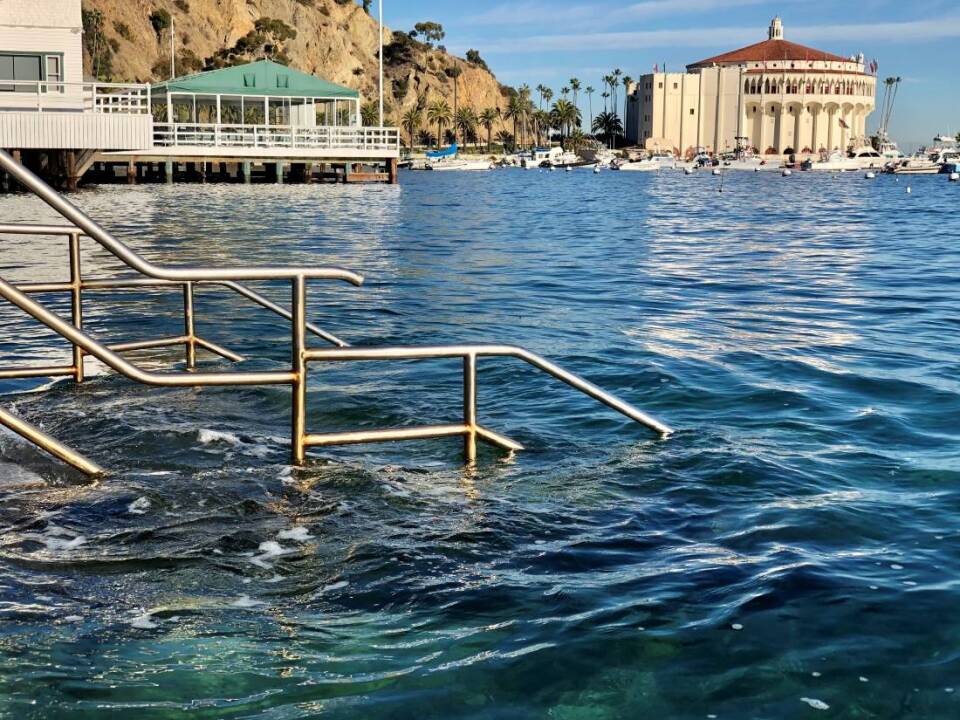Truth matters. Community matters. Your support makes both possible. LAist is one of the few places where news remains independent and free from political and corporate influence. Stand up for truth and for LAist. Make your year-end tax-deductible gift now.
If you ‘sea’ something, say something: Prepare for climate change by photographing king tides

Editor's note: This article was originally published in November 2024. Here's an update for Thursday, Nov. 6, 2025.
From Santa Barbara to San Clemente, king tides are arriving again in Southern California, and you can still help document them as part of the King Tides Project.
Today, as well as in December and January, king tides will affect coastal areas up and down California, with some variation depending on where you are. Check the tide map on the King Tides Project website to see a spot that needs photographing, and then read their instructions for how to participate.
And remember to be cautious around high water and unpredictable waves — no photo is worth risking your personal safety.
—Matthew Ballinger, LAist senior editor
Read on ... for the original article about the project and why it matters.
As the season’s first king tides arrive this weekend, California’s coastline will be vulnerable to flooding — and it might not look too different from projected sea levels as they rise in the decades to come.
To help understand the effects of these tides and rising sea levels more generally, the California Coastal Commission is asking citizen scientists to take pictures and document flooding this weekend as part of their ongoing King Tides Project.
Why study king tides?
King tides are essential previews of higher sea levels, helping us predict areas that may be prone to flooding now and in the decades to come.
“When we have photos of them, it helps us understand what is vulnerable to flooding today, what's already vulnerable to flooding during extreme tides and storm events,” said Annie Kohut Frankel, who manages the King Tide Project at the California Coastal Commission. “But it also helps us understand what we will expect to see as sea level rises over the next few decades.”
While it isn’t clear exactly how much sea levels will rise — that will depend on how much humans are able to limit their combustion of fossil fuels — Frankel said that current estimates point to about 1 to 2 feet of sea level rise over the next few decades.

“If on a king tide, your favorite beach is underwater, within a few decades, your favorite beach may be underwater every day,” she said. “If a road is flooded during king tides, that road is going to be impacted by sea level rise.”
If you can’t make it to the beach in the morning, these king tides will bring super-low tides in the afternoon, so it could be a great opportunity to look for tide pools.
How to help
First things first: In order to take a picture of the king tides, you’ll need to be there for them. This weekend’s high tides will take place in early to mid-morning Friday through Sunday. You can find a map of high tide times all along the California coast here.
Once you’re there, keep an eye out for higher water levels along beaches, bike paths, and roads — especially if you’re familiar with the area and can spot things out of the ordinary.
Before taking photos, Frankel recommended making sure your location services or geotagging settings are enabled to help scientists find where you took the picture easily.
Then, when it’s time to snap a photo, make sure to include a frame of reference in the photo for how high the water is — you can save the beautiful shots looking onto the horizon for your own personal collection.
“It's not going to be the best picture to take looking straight out at the ocean where we can't see how high the water is,” Frankel said. “I recommend that you look up the shore or down the shore so you can see the water in relation to a bluff or a seawall or a pier or a beach access stairway.”

King tides are also responsible for less obvious types of flooding away from the beach. If you notice a wetland totally covered with water, or if water appears to come up from a manhole or storm drain near the beach, Frankel recommended taking a picture of that, too, since they’ll also help scientists understand the effects of rising tides.
“Identifying places like that is really helpful,” Frankel said. “We don't necessarily know where all those spots are.”
If you can’t make it to the beach this weekend, there will be another round of king tides you can observe from Dec. 13 to 15 — and the California King Tide Project will be collecting data then, too.
Where to submit the photos
Once you have the photos, upload them to the California Coastal Commission’s website here. They’ll then be added to an interactive king tide map built over the years from citizen scientists across the state.
You can also find a gallery of photo submissions from past years on the Coastal Commission’s site. And in this reporter’s humble opinion, while the photos were taken for science rather than for aesthetics, many of them are quite striking in their own right.
“We can't help that the California coast is beautiful,” Frankel said. “We're planning for the future, we're understanding challenges and vulnerabilities, but we're also appreciating these very special places that we love.”











